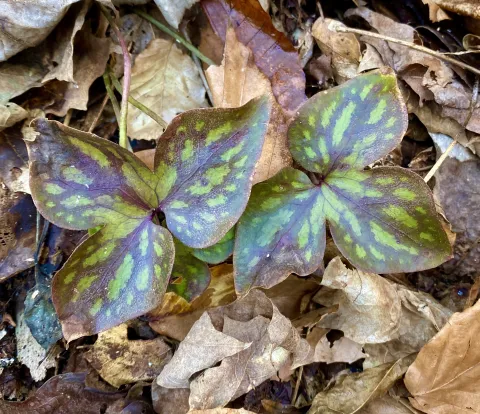Balms, Banes, and Worts: Plant Name Curiosities

Liverwort has a leaf lobe shaped like a liver and was used to treat liver ailments.
By Steve Roark
Volunteer, Cumberland Gap National Historical Park
As a botany enthusiast and student of medicinal plants, I keep running across plants with recurring name components. The terms balm, bane, and wort come up often, so I decided to see why. Prepare to delve into the world of ethnobotany, the study of plants used by humans.
All three terms were added to useful plants back in the day to indicate what they were good for. The term “balm” is probably familiar, and refers to something applied as a medicinal ointment, such as a salve. Locally I’ve ran across three plants with this name. Beebalm is a fragrant mint with large handsome flowers. It has antiseptic and antibacterial properties and was applied as a compress or made into an ointment to relieve pain and promote healing of minor wounds and insect stings. Lemon Balm is also a mint that was believed to the same healing properties. Balm of Gilead is a tree not native to our area but was brought in and planted for its winter buds, which contain a sticky resin used to make a healing salve.
A “bane” is defined as something causing great distress or harm. Its origin is the old English word “bana”, meaning destroyer or causing death. In botany it’s an archaic term referring to plants that are poisonous. It was also used to name some plants thought to have prophylactic (disease preventing) qualities. Locally we have several plant banes: Daisy Fleabane is an aster-like white flowering plant that is a common yard weed. It is thought to have insect repelling properties, and back in the day when mattresses were homemade of straw, Fleabane was added to repel fleas. Wolfbane, also known as Monkshood, is a purple wildflower that is highly toxic. It was used to make poison tipped arrows to better assure a kill, one target being dangerous rivals like wolves. Henbane is poisonous but not to chickens. The word “hen” may be a derivation of the word “bhelena”, which means “crazy plant”. Misused, henbane can cause hallucinations and death.
By far the most common term in plant names that refer to their use is “wort”. It is derived from the old English “wryt”, which means root, and a there are many local plants with this name. Wort is used to indicate plants or herbs that have a medicinal use, with the first part of the name denoting the ailment the plant can be used for. For instance, Toothwort is a white flowering plant that was used to treat a toothache. Liverwort is a local plant with leaves in the shape of a liver, and was used to treat liver problems. Lungwort, an earlier name for Virginia Bluebell, was used to treat lung ailments like tuberculosis and whooping cough. Another name for Red Trillium is birthwort, which was used to induce labor or ease labor pain. Spleenwort is a small fern that was used to treat disorders of the spleen. Spiderwort is a purple blooming flower that was used to treat insect bites. A very popular herbal medicine found in most drug stores is St. John’s Wort, a yellow flowering plant that traditionally blooms on St. John’s Day (June 24), a day celebrated by the Freemasons in honor of John the Baptist. It is reported to have calming qualities.
The list of local plants that were traditionally used for medicinal purposes is long. So much so that a long ago wild plant collector from east Tennessee once said: “The good Lord has put these yarbs here for man to make hisself well with. They is a yarb, could we but find it, to cure every illness.”
- Log in to post comments